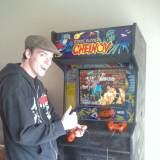Retro How-TO: Now You're Playing With Power!
By Punk1984 5 Comments
We've come a long way baby. Sitting here looking deeply into my HD LCD TV, I love it. A crisp colorful picture is all I've ever wanted. It is 16:9, so many inches, has a banging surround sound system that you can hear down the block and I've even managed to get everything down to 1 or 2 remotes.
Now I want to play Super Mario Bros. 3 on it.
Welcome to the Retro-gamer's dilemma; making the old equipment jive correctly with the new equipment. Sure we all know how to hook up a system to a TV, but there are a ton of pointers for those of you who want to hook, 5, 6, 7 or whatever up to one TV and not have to swap cables all the time.
The Power Problem:
Most household outlets feature 2 power plugs. Well your TV is probably going to be plugged into one of those so that leaves you with 1. You're going to need a way to increase your plug base with out decreasing your power.
What you don't want, an extension cord. Extension cords come in a variety of lengths and will usually have 1 or 3 plugs at the end. Extension cords are great for stringing Christmas lights but should not be used for electronic equipment. They usually offer no surge protection and are not meant to handle continual long term usage. A damaged extension cord can also result in under powering which is a quick way to ruin your TV or game system.
What you do want is a simple surge protector. Surge protectors are sold at office stores for less than 20$. I prefer black because they are easier to hide under an entertainment center and will reflect less light if you are playing in a dark room. Offering protection from common electrical surges and keeping everything down to a single on/off switch helps when you want to turn your system off for long periods. The most common downside with surge protectors is plug placement and orientation. This is not normally a problem in office settings but with a retro-gaming setup you'll run into many odd shaped AC/DC adapters.
What you really need, is a power squid. Power Squids are surge protectors that end in bendable extensions. While they usually have less plugs than surge protectors (5 plugs is common) and are more expensive (expect to pay $5-$10 more than similar surge protectors) the squid's "arms" will let you plug and arrange your AC/DC adapters easily.
Protip: Twisty Ties, once you are done wiring your entertainment center and you've arranged all your consoles take 15 minutes to wrap and tie off excess power cords. I keep mine neatly piled behind the entertainment center. You can also place the wrapped power coils behind the consoles themselves but this will cut down on air flow and increase heat which can damage your systems.
I'll post again with other tips for building the perfect blend of a Retro and Cutting Edge gaming entertainment center.
